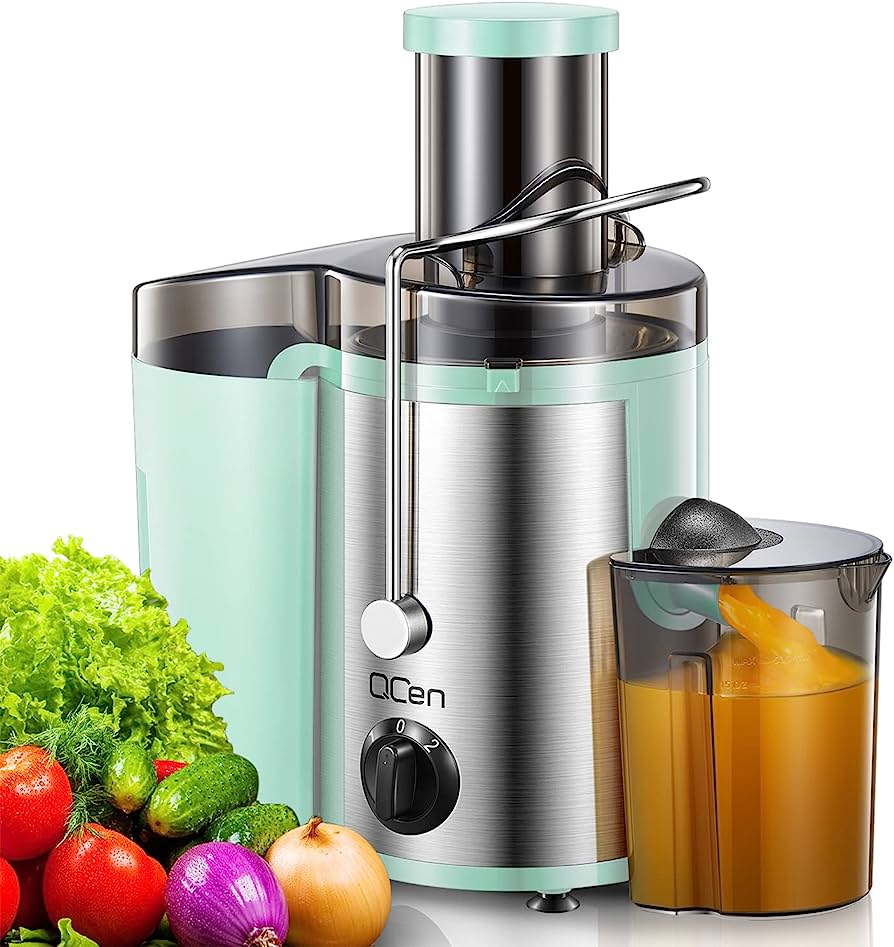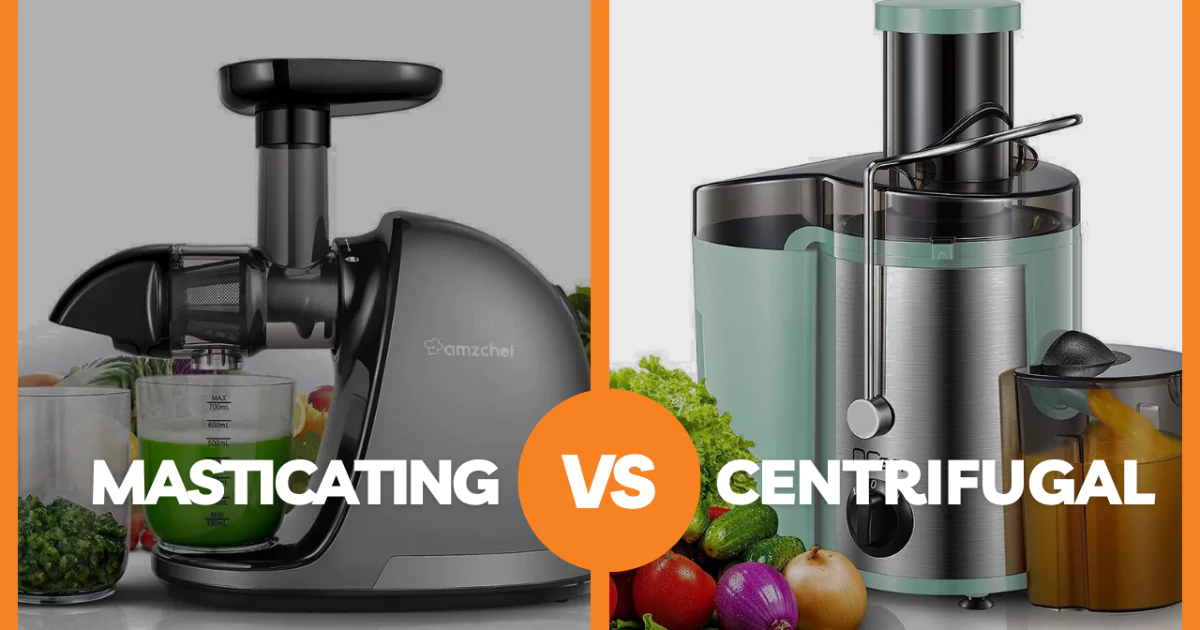As individuals try to include more fruits and vegetables, juicing has gained popularity recently. Choosing the best juicer for your requirements might take time, given the large selection of juicers on the market. There are two common varieties of juicers. We shall examine Masticating vs Centrifugal Juicer in this post and each category’s advantages.
What Is A Masticating Juicer?

A specific kind of juicer called a masticating juicer works by slowly crushing and grinding fruits and vegetables to extract the juice. Unlike centrifugal juicers, which chew and compress the product using fast-spinning blades to extract the juice from the pulp, masticating juicers operate at a lower pace and employ an auger or gear system.
Thanks to this gentle, gradual procedure, the juice is preserved with more nutrients, enzymes, and antioxidants, making for a better-tasting, more nutrient-dense beverage. Leafy greens, wheatgrass, and other fibrous vegetables may be successfully juiced using masticating juicers, which are also well-recognized for this capacity.
They often create less heat and noise than centrifugal juicers, which might assist in preserving the juice’s quality. Masticating juicers may frequently make nut butter, baby food, sorbets, and pasta while doing other tasks.
Types Of Masticating Juicers
Juicing machines that work slower than centrifugal juicers include masticating juicers, commonly referred to as slow or cold press juicers. They chew or grind fruits and vegetables to extract the juice, which increases juice production and nutritional retention. Due to its capacity to generate juice with less oxidation and heat generation—which helps retain the natural enzymes and nutrients contained in the product—masticating juicers are well-liked by health-conscious people.
Masticating juicers come in several varieties, each with unique characteristics and advantages. These consist of:
Single Auger Juicers:
A single gear or auger that turns slowly to crush and compress the product against a stainless steel mesh screen is the main component of single auger masticating juicers. This method successfully separates the pulp from the juice. The versatility of single auger juicers allows them to process a variety of fruits, vegetables, leafy greens, and even wheatgrass. They are appropriate for most home consumers and typically cheaper than other best masticating juicer varieties.
Twin Gear Juicers:
Twin-gear masticating juicers smash and ground the produce using two interlocking gears that rotate in opposition. Juice may be extracted more effectively with this dual-gear system while oxidation is reduced and nutrient retention is increased. Twin gear juicers work exceptionally well for juicing fibrous greens like kale and wheatgrass and tough vegetables like carrots and beets. They are often more costly, heavier, and bigger than single-auger variants.
Vertical Juicers:
With an upright feeding tube and a vertical construction, vertical masticating juicers make it simple to feed entire fruits and vegetables without pre-cutting. Compared to horizontal variants, these juicers often have a smaller footprint, making them more space-efficient. Additional features like self-cleaning mechanisms and movable pulp control settings are frequently included with vertical juicers. Various foods, including leafy greens, soft fruits, and hard vegetables, can be used with them.
Horizontal Juicers:
The feeding chute for horizontal masticating juicers is either in the front or side of the machine. They often have a bigger footprint than vertical versions but also have certain benefits. Horizontal juicers are well-known for their adaptability and capacity to handle a range of products, including leafy greens, fruits, vegetables, nuts, and seeds. Some horizontal juicers also have extra sorbet, pasta, and nut butter production equipment.
Commercial Juicers:
Commercial masticating juicers are potent devices for high-volume juicing in restaurants or juice bars. These juicers can swiftly and effectively handle large amounts of produce and are designed to endure continuous operation. More extensive feeding chutes and robust construction are standard features of commercial juicers, which may accept entire fruits and vegetables.
Pros And Cons Of Masticating Juicers
Now that you have an in-depth idea about slow juicers, here are some of their pros and cons:
Pros
- Because juicing is a gradual process, it helps foods retain more nutrients and enzymes.
- Increase the juice yield produced by pressing more juice from fruits and vegetables.
- May juice a broad range of food, including wheatgrass, herbs, and leafy greens.
- Juice has a longer shelf life because less oxidation occurs while it is juiced.
- Compared to centrifugal juicers, quieter operation.
- It can produce sorbets, infant food, and nut butter, among other culinary products.
Cons
- As it is a slow juicer machine, it has slower juice extraction than centrifugal juicers.
- Costlier on average than centrifugal juicers.
- Because of the intricate pattern, it requires extra time and effort to clean.
- Some models’ narrower feeding chutes necessitate additional preparation time for chopping fruit into more manageable portions.
- Juicers that use centrifugal technology are bulkier, heavier, and need more counter space.
What Is A Centrifugal Juicer?

A kitchen tool called the best centrifugal juicer squeezes the juice out of fruits and vegetables. It works by chopping the fruit with a fast-spinning blade and separating the liquid from the pulp. The mesh screen traps the pulp while letting the juice flow through and is pressed against the chopped vegetables. The juice from the solid portions of the fruits and vegetables may be separated thanks to the centrifugal force produced by the spinning action. Juicers of this kind are renowned for their quick operations and capacity to handle large amounts of vegetables. However, it could be less effective in squeezing juice from leafy greens and might generate some heat, reducing the juice’s nutritious value.
Types Of Centrifugal Juicers
A common form of juicer that uses swiftly spinning blades to extract juice from fruits and vegetables is the centrifugal juicer. They process the produce into a pulp and separate the juice from the pulp using centrifugal force. This kind of juicer is well-liked by many home juicing lovers due to its speed and efficiency.
There are various kinds of centrifugal juicers on the market, each with unique characteristics and advantages. We will go into great depth about the many different types of centrifugal juicers.
Standard Centrifugal Juicers:
The standard model is the most prevalent kind of centrifugal juicer on the market. They frequently include a large feed tube that enables the insertion of entire fruits and vegetables without the requirement for pre-cutting. The fruit is then put through a rotating blade, which pulpified it. After that, the pulp is spun rapidly to separate the juice from the pulp using centrifugal force. The pulp is expelled into a separate pulp container, while the fluid is collected in another container. Standard centrifugal juicers are popular for people who desire quick and straightforward juicing because of their reputation for efficiency and speed.
Compact Centrifugal Juicers:
Compact centrifugal juicers are more portable and lightweight than regular centrifugal juicers. They are made to take up less countertop space and are frequently more portable, making them perfect for people with small kitchens or those who want to take their juicer with them everywhere they go. Compact centrifugal juicers have a strong motor and can handle a range of fruits and vegetables despite their tiny size. Compared to conventional centrifugal juicers, they often feature a smaller feed funnel, which could necessitate some pre-cutting of food before juicing.
High-End Centrifugal Juicers:
A juicer’s highest performance and features are what high-end centrifugal juicers are made for. These juicers frequently have more robust motors, enabling them to handle more challenging material, such as leafy greens and root vegetables. They could also include variable speed settings, which let you change the juicer’s speed according to the juiced food. High-end centrifugal juicers are frequently constructed from better-quality components and could have extended warranties. Although they could cost more than basic or small centrifugal juicers, they provide better performance and durability.
Wide-Mouth Centrifugal Juicers
Wide-mouth juicers feature a more extensive feed channel than regular centrifugal juicers. This saves time and effort during the juicing process by enabling the insertion of entire fruits and vegetables without the need for pre-cutting. Wash-mouth centrifugal juicers are efficient for people who wish to juice more significant amounts of food or would rather spend less time slicing fruits and vegetables before juicing.
Dual-Speed Centrifugal Juicers
Centrifugal juicers with two-speed settings provide you with more options. This enables you to change the juicer’s speed by the type of juiced vegetables. Higher rates are better suited for firmer fruits and vegetables, while lower speeds are good for softer fruits and leafy greens. Dual-speed centrifugal juicers give you more control over the juicing procedure and guarantee the best juice extraction from various crop varieties.
Pros And Cons Of Centrifugal Juicers
Here are some of the pros and cons of the centrifugal juicers:
Pros
- Fast juicing process
- Easy to use and clean
- Affordable price range
- Can handle a wide variety of fruits and vegetables
- Require less preparation time as they often have larger feeding chutes
- Produce juice quickly due to high-speed spinning
Cons
- Less effective at extracting juice when compared to other juicers – May produce more heat while juicing, thereby reducing the juice’s nutritional content – Tends to make more foam and oxidation, shortening the juice’s shelf life
- Not appropriate for juicing leafy greens and wheatgrass since they cannot get the most juice from these ingredients. Noisy operation owing to high-speed spinning.
Masticating Vs. Centrifugal Juicer: The Main Differences
If you want to do a quick review and desire to desire to know cold press vs. centrifugal juicer competitors, here is the quick and comprehensive difference between both juicers:
- Masticating juicers use a slow and gentle process to extract juice, while centrifugal juicers use high-speed spinning blades.
- Masticating juicers produce higher-quality juice with more nutrients and enzymes, while centrifugal juicers produce less nutritional value.
- Masticating juicers extract juice from leafy greens and wheatgrass more efficiently, while centrifugal juicers are better for hard fruits and vegetables.
- Masticating juicers operate quietly and have a longer lifespan, while centrifugal juicers are louder and may have a shorter lifespan.
Centrifugal Vs. Masticating Juicer: Which One Should I Buy?
The choice between a centrifugal and a masticating juicer ultimately comes down to your needs and tastes. Centrifugal juicers are a popular option for people who value convenience and affordability because they are often quicker and cheaper. They function by pressing the juice out of fruits and vegetables using fast-spinning blades.
The juice from produce is crushed and extracted using an auger by masticating juicers, which work slowly. More nutrients and enzymes are known to be preserved with this technique, leading to more excellent-quality juice and longer shelf life.
Health-conscious people who respect the nutritional worth of their juice frequently prefer masticating juicers. A centrifugal juicer can be superior if speed and cost are your primary considerations. However, a masticating juicer would be the best option if you prioritize nutrient retention and are prepared to spend more money on a higher-quality juicer.
FAQs
Which Juicer Style Is The Best?
The ideal juicer design varies on individual demands and tastes. Masticating juicers are slower but extract more juice and nutrients than centrifugal juicers, which are quicker and more expensive.
How Much Does Speed Matter?
Speed is crucial in many facets of life, including technology, sports, transportation, and communication. Efficiency, performance, productivity, and user experience may all be adversely impacted.
What Is The Best Way To Clean A Juicer?
A juicer may be cleaned most effectively by disassembling it, rinsing the components with warm water, scrubbing them with a brush or sponge, and thoroughly drying them before reassembling.
What Can I Put In A Juicer?
You can put various fruits and vegetables in a juicer, such as apples, oranges, carrots, kale, and celery.
Which Type Of Juicer Is Better For Juicing Leafy Greens?
The masticating juicer is generally considered better for juicing leafy greens due to its slow and efficient extraction process, which preserves nutrients and yields higher juice quality.
Conclusion
In conclusion, the argument over masticating vs. centrifugal juicers has persisted. Before choosing a juicer, people should consider their unique needs and preferences because both types have their own benefits and drawbacks.






